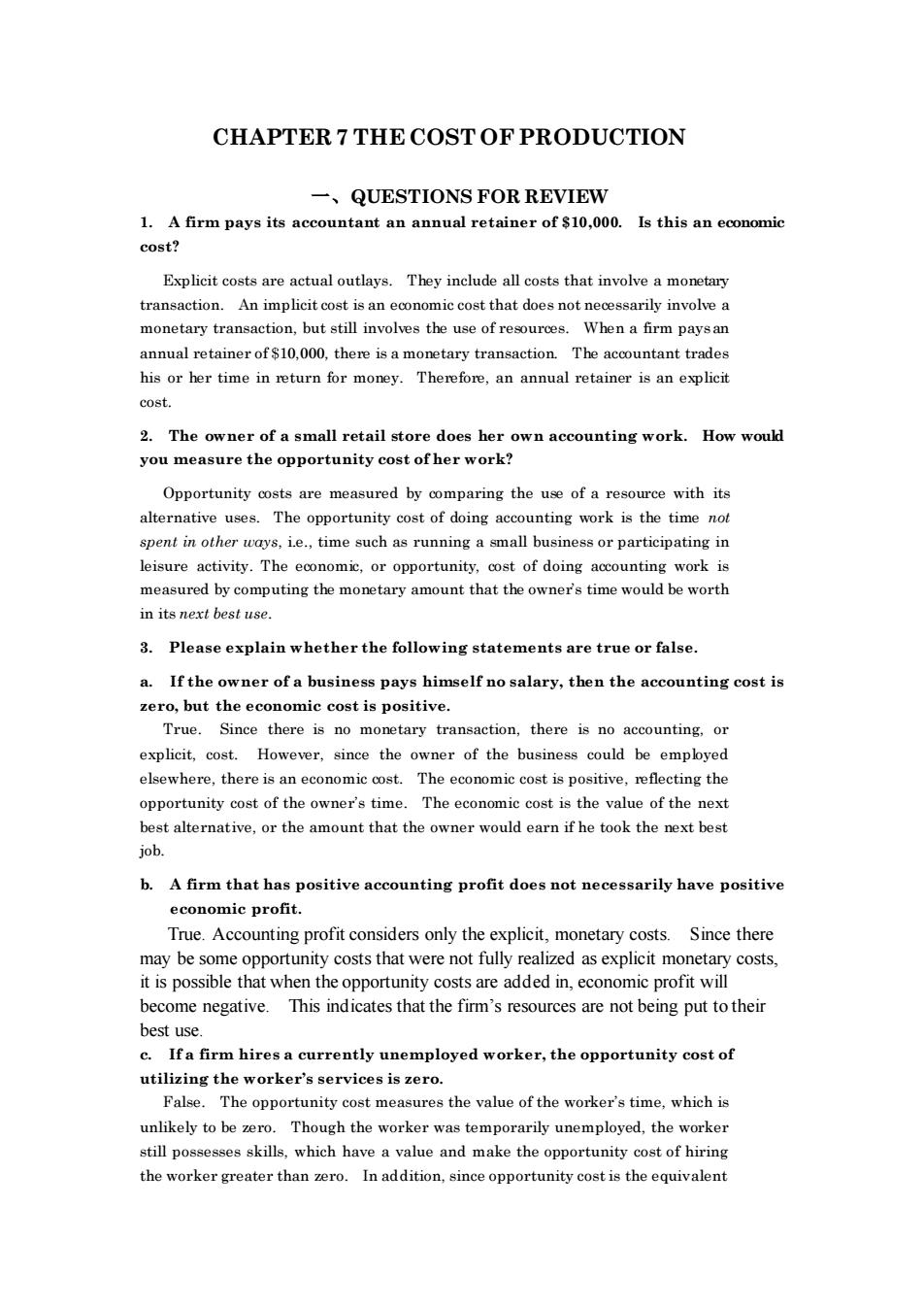
CHAPTER 7 THE COST OF PRODUCTION QUESTIONS FOR REVIEW 1.A firm pays its accountant an annual retainer of $10,000.Is this an economic cost? Explicit costs are actual outlays.They include all costs that involve a monetary transaction.An implicit cost is an eor mic cost that does not nec ily involve monetary tran When a firm payaa annual retainer of $10.000,there is a monetary transaction.The accountant trades his or her time in return for money.Therefore,an annual retainer is an explicit cost. 2.The owner of a small retail store does her own accounting work.How would you measure the opportunity cost of her work? Opportunity costs are measured by omparing the use of a res with its alternative The opportunity cost of doing accounting work is the time no spent in other uays,i.e.time such as running a small business or participating in leisure activity.The economic,or opportunity,cost of doing accounting work is measured by computing the monetary amount that the owner's time would be worth in its next best use」 3.Please explain whether the following statements are true or false Ifthe owner of a business pays himself no salary,then the accounting co zero,but the eco st is positive True Since there is no monetary transaction,there is no accounting.or explicit,cost. However,since the owner of the business could be empbyed elsewhere,there is an economic cost.The economic cost is positive.reflecting the alte or the amount that the owner would earn if he took the next best job. b.A firm that has positive accounting profit does not necessarily have positive economic profit. True.Accounting profit considers only the explicit.monetary costs.Since there may be some opportunity costs that were not fully realized as explicit monetary costs at w the opportunityc e added in,econor p ofit will become negative.This indicates that the firm's resources are not being put to their best use. c.Ifa firm hires a currently unemployed worker,the opportunity cost of utilizing the worker's services is zero. False.The opportunity cost measures the value of the worker's time.which is unlikely to bez Though the worker was temporarily unemployed,the worker still possesses skills,which have a value and make the opportunity cost of hiring the worker greater than zero.In addition,since opportunity cost is the equivalent
CHAPTER 7 THE COST OF PRODUCTION 一、QUESTIONS FOR REVIEW 1. A firm pays its accountant an annual retainer of $10,000. Is this an economic cost? Explicit costs are actual outlays. They include all costs that involve a monetary transaction. An implicit cost is an economic cost that does not necessarily involve a monetary transaction, but still involves the use of resources. When a firm pays an annual retainer of $10,000, there is a monetary transaction. The accountant trades his or her time in return for money. Therefore, an annual retainer is an explicit cost. 2. The owner of a small retail store does her own accounting work. How would you measure the opportunity cost of her work? Opportunity costs are measured by comparing the use of a resource with its alternative uses. The opportunity cost of doing accounting work is the time not spent in other ways, i.e., time such as running a small business or participating in leisure activity. The economic, or opportunity, cost of doing accounting work is measured by computing the monetary amount that the owner’s time would be worth in its next best use. 3. Please explain whether the following statements are true or false. a. If the owner of a business pays himself no salary, then the accounting cost is zero, but the economic cost is positive. True. Since there is no monetary transaction, there is no accounting, or explicit, cost. However, since the owner of the business could be employed elsewhere, there is an economic cost. The economic cost is positive, reflecting the opportunity cost of the owner’s time. The economic cost is the value of the next best alternative, or the amount that the owner would earn if he took the next best job. b. A firm that has positive accounting profit does not necessarily have positive economic profit. True. Accounting profit considers only the explicit, monetary costs. Since there may be some opportunity costs that were not fully realized as explicit monetary costs, it is possible that when the opportunity costs are added in, economic profit will become negative. This indicates that the firm’s resources are not being put to their best use. c. If a firm hires a currently unemployed worker, the opportunity cost of utilizing the worker’s services is zero. False. The opportunity cost measures the value of the worker’s time, which is unlikely to be zero. Though the worker was temporarily unemployed, the worker still possesses skills, which have a value and make the opportunity cost of hiring the worker greater than zero. In addition, since opportunity cost is the equivalent
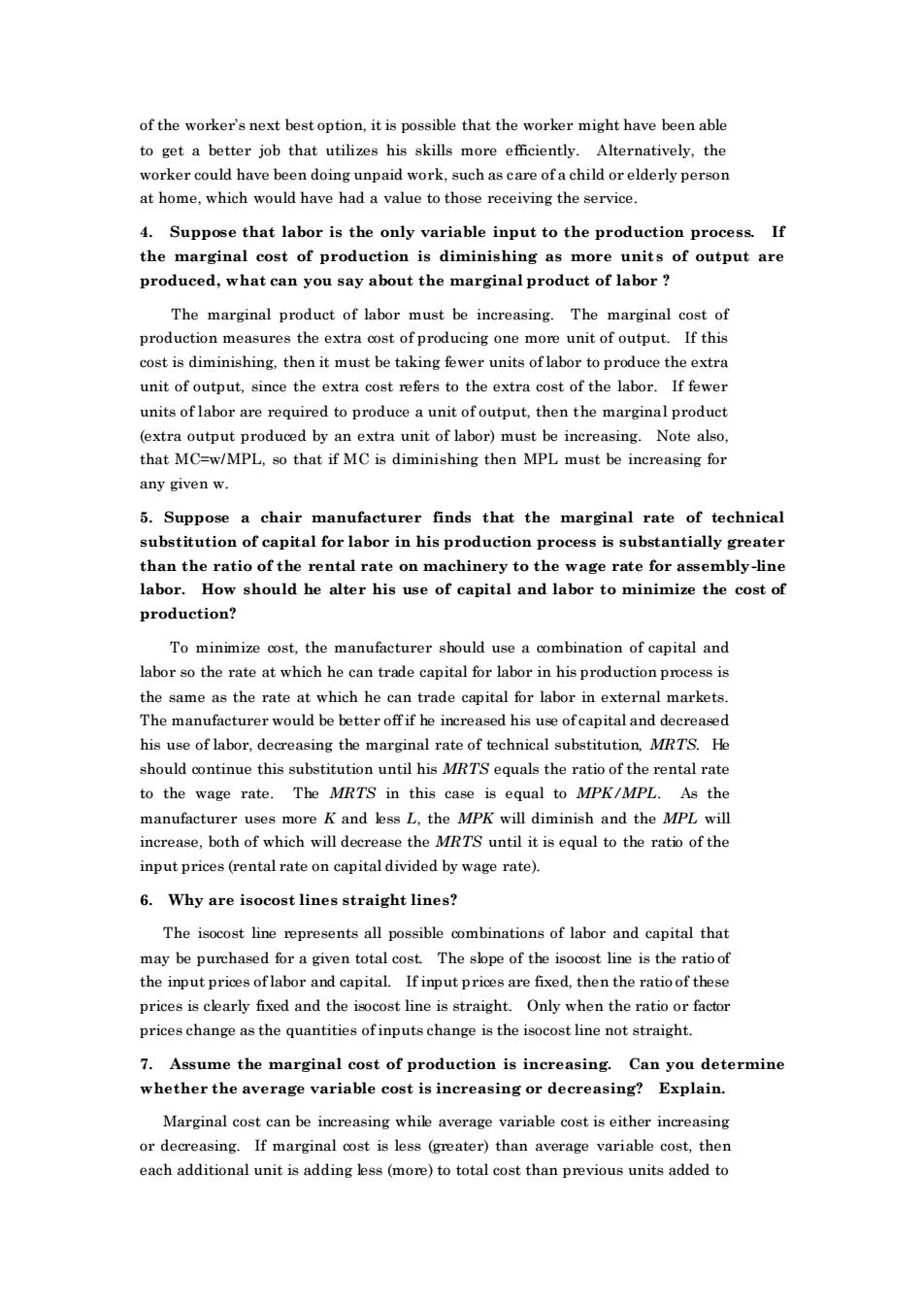
of the worker's next best option.it is possible that the worker might have been able to geta better job that utilizes his skills more efficiently Alternatively,the worker could have been doing unpaid work,such as care of a child or elderly person at home,which would have had a value to those receiving the service. 4.Suppose that labor is the only variable input to the production process.If the marginal cost of production is diminishing as more units of output are produced,what can you say about the marginal product of labor? The marginal product of labor must be increasing.The marginal cost of production m the extr of producing one m unit of o put. cost is diminishing,then it must be taking fewer units of labor to produce the extra unit of output.since the extra cost refers to the extra cost of the labor.If fewer units of labor are required to produce a unit of output,then the marginal product extra output produced by an extra unit of labor)must be increasing.Note also that MC-w/MPL,so that if MC is diminishing then MPL must be sing for any given w. 5.Suppose a chair manufacturer finds that the marginal rate of technical substitution of capital for labor in his production process is substantially greater than the ratio of the rental rate on machinery to the wage rate for assembly-line labor.How should he alter his use of capital and labor to minimize the cost of production? To minimize c t the manufacturer should use a combination of capital and labor so the rate at which he can trade capital for labor in his production proces is the same as the rate at which he can trade capital for labor in external markets. The manufacturer would be better off if he increased his use ofcapital and decreased his use of labor,decreasing the marginal rate of technical substitution,MRTS.He should continue this substitution until his MRTSequals the ratio of the rental rate to the wage rate. The MRTS in this s equal to MPK/MPL manufacturer uses more K and less L,the MPK will diminish and the MPL will increase,both of which will decrease the MRTS until it is equal to the ratio of the input prices(rental rate on capital divided by wage rate). 6.Why are isocost lines straight lines? The isocost line represents all possible combinations of labor and capital that a g total osThe pe of are I fixed,t hen the ratioof prices is clearly fixed and the isocost line is straight.Only when the ratio or factor prices change as the quantities of inputs change is the isocost line not straight. 7.Assume the marginal cost of production is increasing.Can you determine whether the average variable cost is increasing or decreasing?Explain. Marginal cost can be increasing while average variable cost is either increasing or decreasing.If marginal cost is less (greater)than average variable cost,then each additional unit is adding s(more)to total cost than previous units added to
of the worker’s next best option, it is possible that the worker might have been able to get a better job that utilizes his skills more efficiently. Alternatively, the worker could have been doing unpaid work, such as care of a child or elderly person at home, which would have had a value to those receiving the service. 4. Suppose that labor is the only variable input to the production process. If the marginal cost of production is diminishing as more unit s of output are produced, what can you say about the marginal product of labor ? The marginal product of labor must be increasing. The marginal cost of production measures the extra cost of producing one more unit of output. If this cost is diminishing, then it must be taking fewer units of labor to produce the extra unit of output, since the extra cost refers to the extra cost of the labor. If fewer units of labor are required to produce a unit of output, then the marginal product (extra output produced by an extra unit of labor) must be increasing. Note also, that MC=w/MPL, so that if MC is diminishing then MPL must be increasing for any given w. 5. Suppose a chair manufacturer finds that the marginal rate of technical substitution of capital for labor in his production process is substantially greater than the ratio of the rental rate on machinery to the wage rate for assembly-line labor. How should he alter his use of capital and labor to minimize the cost of production? To minimize cost, the manufacturer should use a combination of capital and labor so the rate at which he can trade capital for labor in his production process is the same as the rate at which he can trade capital for labor in external markets. The manufacturer would be better off if he increased his use of capital and decreased his use of labor, decreasing the marginal rate of technical substitution, MRTS. He should continue this substitution until his MRTS equals the ratio of the rental rate to the wage rate. The MRTS in this case is equal to MPK/MPL. As the manufacturer uses more K and less L, the MPK will diminish and the MPL will increase, both of which will decrease the MRTS until it is equal to the ratio of the input prices (rental rate on capital divided by wage rate). 6. Why are isocost lines straight lines? The isocost line represents all possible combinations of labor and capital that may be purchased for a given total cost. The slope of the isocost line is the ratio of the input prices of labor and capital. If input prices are fixed, then the ratio of these prices is clearly fixed and the isocost line is straight. Only when the ratio or factor prices change as the quantities of inputs change is the isocost line not straight. 7. Assume the marginal cost of production is increasing. Can you determine whether the average variable cost is increasing or decreasing? Explain. Marginal cost can be increasing while average variable cost is either increasing or decreasing. If marginal cost is less (greater) than average variable cost, then each additional unit is adding less (more) to total cost than previous units added to
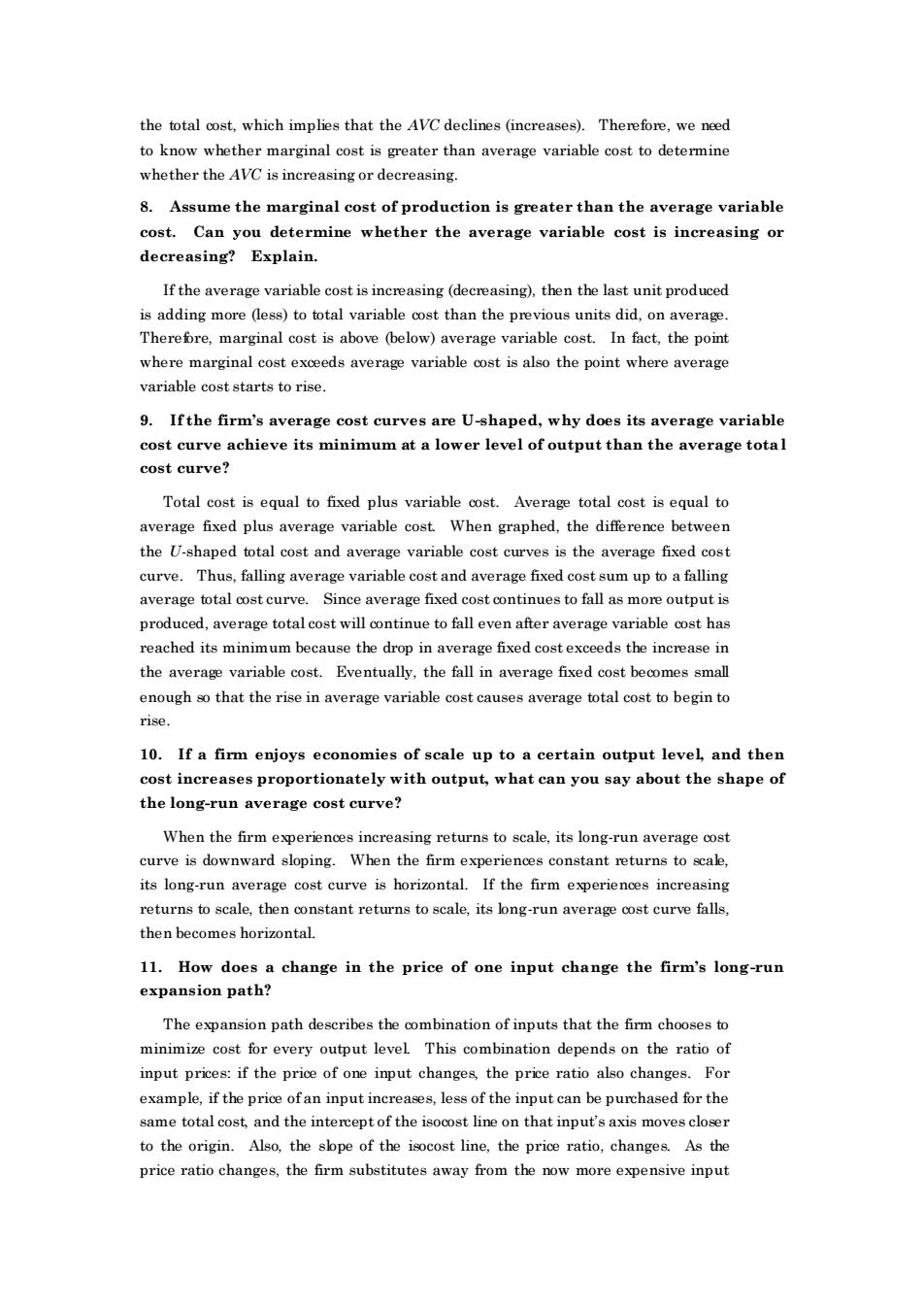
the total cost,which implies that the AVC declines (increases).Therefore,we need toknow whether marginal cost is greater than average variable cost to determine whether the AVC is inereasing or deereasing. 8.Assume the marginal cost of production is greater than the average variable cost.Can you determine whether the average variable cost is increasing or decreasing?Explain. If the average variable cost is increasing(decreasing),then the last unit produced is adding more dess)to total variable oost than the previous units did.on average Therefre,marginal cost is above(below)averag variable cost.In fact.the poir where marginal variable the point where average variable cost starts to rise. 9.Ifthe firm's average cost curves are U-shaped,why does its average variable cost curve achieve its minimum at a lower level of output than the average total cost curve? Total cost is equal to fixed plus variable cost.Average total cost is equal to 套芝地u恤 tal cost and average variable cost curves is the average fixed cost curve.Thus,falling average variable cost and average fixed cost sum up to a falling average total cost curve.Since average fixed cost continues to fall as more output is produced,average total cost will continue to fall even after average variable oost has eached its min imum because the drop in average fixed cost exceeds the increase in the average variable cost. enough so that the rise in average variable cost causes average total cost to begin to rise. 10.If a firm enjoys economies of scale up to a certain output leveL and then cost increases proportionately with output,what can you say about the shape of the long-run average cost curve? When the firm erienes inc g returns to cale,its long-run ur loping Wher the constant returns to scak If the firm experiences increasing returns to scale.then constant returns to scale,its long-run average cost curve falls. then becomes horizontal. 11.How does a change in the price of one input change the firm's long-run expansion path? The expansion path describes the combination of inputs that the firm chooses to minimize cost for every ou utput level This combination depends on the ratio of input prices:if the price of one input changes,the price ratio also changes.For example,if the price ofan input increases,less of the input can be purchased for the same total cost and the intercept of the isocost line on that input's axis moves closer to the origin.Also,the slope of the isocost line.the price ratio.changes.As the price ratio changes,the firm substitutes away from the now more expensive input
the total cost, which implies that the AVC declines (increases). Therefore, we need to know whether marginal cost is greater than average variable cost to determine whether the AVC is increasing or decreasing. 8. Assume the marginal cost of production is greater than the average variable cost. Can you determine whether the average variable cost is increasing or decreasing? Explain. If the average variable cost is increasing (decreasing), then the last unit produced is adding more (less) to total variable cost than the previous units did, on average. Therefore, marginal cost is above (below) average variable cost. In fact, the point where marginal cost exceeds average variable cost is also the point where average variable cost starts to rise. 9. If the firm’s average cost curves are U-shaped, why does its average variable cost curve achieve its minimum at a lower level of output than the average total cost curve? Total cost is equal to fixed plus variable cost. Average total cost is equal to average fixed plus average variable cost. When graphed, the difference between the U-shaped total cost and average variable cost curves is the average fixed cost curve. Thus, falling average variable cost and average fixed cost sum up to a falling average total cost curve. Since average fixed cost continues to fall as more output is produced, average total cost will continue to fall even after average variable cost has reached its minimum because the drop in average fixed cost exceeds the increase in the average variable cost. Eventually, the fall in average fixed cost becomes small enough so that the rise in average variable cost causes average total cost to begin to rise. 10. If a firm enjoys economies of scale up to a certain output level, and then cost increases proportionately with output, what can you say about the shape of the long-run average cost curve? When the firm experiences increasing returns to scale, its long-run average cost curve is downward sloping. When the firm experiences constant returns to scale, its long-run average cost curve is horizontal. If the firm experiences increasing returns to scale, then constant returns to scale, its long-run average cost curve falls, then becomes horizontal. 11. How does a change in the price of one input change the firm’s long-run expansion path? The expansion path describes the combination of inputs that the firm chooses to minimize cost for every output level. This combination depends on the ratio of input prices: if the price of one input changes, the price ratio also changes. For example, if the price of an input increases, less of the input can be purchased for the same total cost, and the intercept of the isocost line on that input’s axis moves closer to the origin. Also, the slope of the isocost line, the price ratio, changes. As the price ratio changes, the firm substitutes away from the now more expensive input
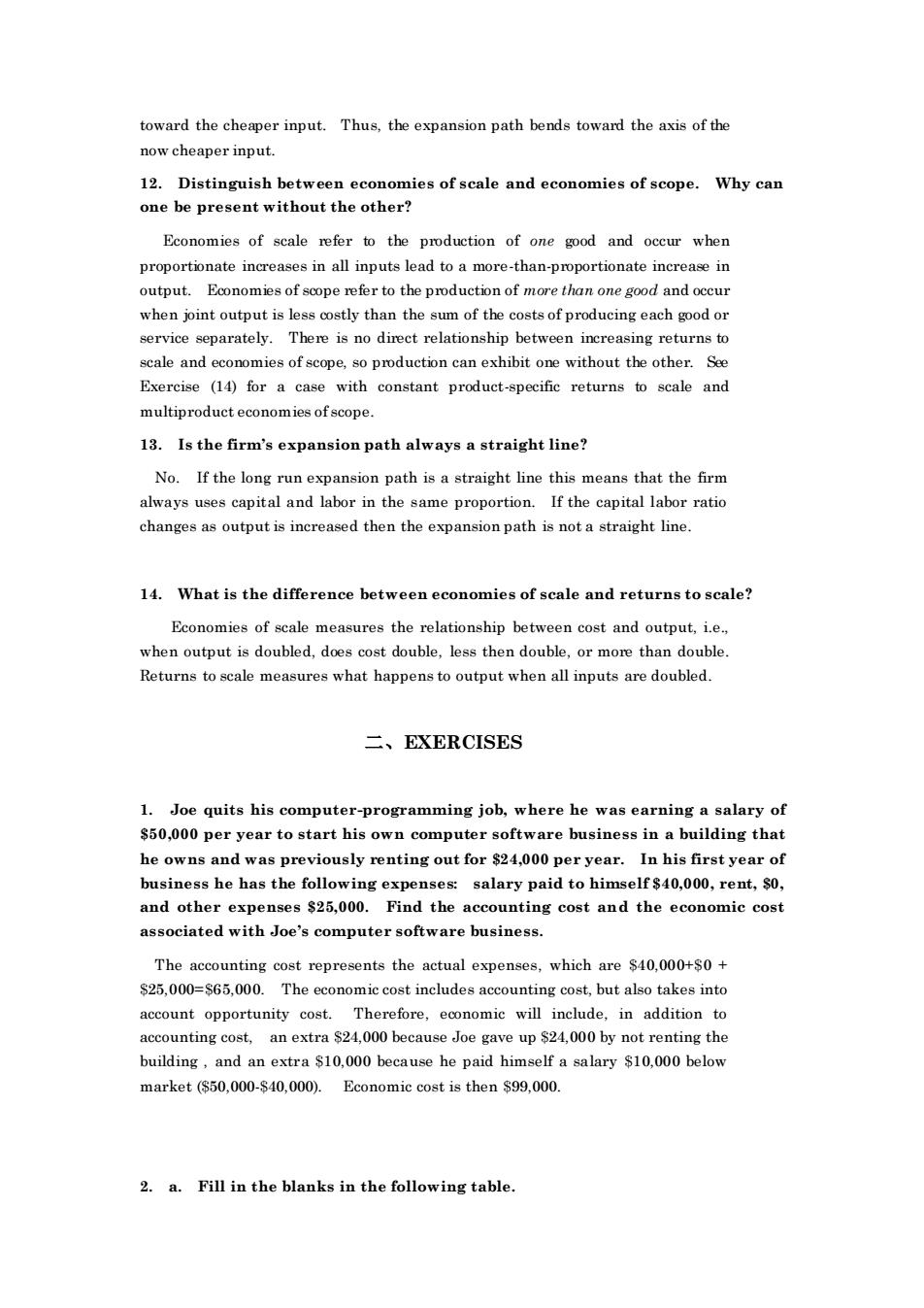
toward the cheaper input.Thus,the expansion path bends toward the axis of the now cheaper input 12.Distinguish betwee one be present without the other? Economies of scale refer to the production of one good and occur when proportionate increases in all inputs lead to a more-than-proportionate increase in output.Eoonomies of scope refer to the production of more than one good and occur each good or e etw g re scale and economies of scope,so production can exhibit one without the other.S Exercise (14)for a case with constant product-specific returns to scale and multiproduct economies of scope. 13.Is the firm's expansion path always a straight line? No.If the long run expansion path is a straight line this means that the firm always uses capital and labor in the same proportion.If the capital labor ratio ehanges as output is increased then the expansion path is not a straight line. 14.What is the difference between economies of scale and returns to scale? Economies of scale measures the relationship between cost and output,i.e when output is doubled,does cost double,less then double.or more than double Returns to scale measures what happens to output when all inputs are doubled. 二、EXERCISES 1.Joe quits his computer-programming job,where he was earning a salary of $50,000 per year to start his own computer software business in a building that he owns and was previously renting out for 00 peryear. In his first year of busine ess he has the following expense salary paid to himself$40,000,rent,$ and other expenses $25,000.Find the accounting cost and the economic cost associated with Joe's computer software business. The accounting cost represents the actual expenses.which are S40.000+S0+ S25.000=S65.000.The economic cost includes accounting cost.but also takes into account oppo ing co an extra $24.000 be Joe ga ep24.000wn0 renting th building,and an extra $10.000 because he paid himself a salary $10.000 below market ($50,000-$40,000).Economic cost is then $99,000. 2.a.Fill in the blanks in the following table
toward the cheaper input. Thus, the expansion path bends toward the axis of the now cheaper input. 12. Distinguish between economies of scale and economies of scope. Why can one be present without the other? Economies of scale refer to the production of one good and occur when proportionate increases in all inputs lead to a more-than-proportionate increase in output. Economies of scope refer to the production of more than one good and occur when joint output is less costly than the sum of the costs of producing each good or service separately. There is no direct relationship between increasing returns to scale and economies of scope, so production can exhibit one without the other. See Exercise (14) for a case with constant product-specific returns to scale and multiproduct economies of scope. 13. Is the firm’s expansion path always a straight line? No. If the long run expansion path is a straight line this means that the firm always uses capital and labor in the same proportion. If the capital labor ratio changes as output is increased then the expansion path is not a straight line. 14. What is the difference between economies of scale and returns to scale? Economies of scale measures the relationship between cost and output, i.e., when output is doubled, does cost double, less then double, or more than double. Returns to scale measures what happens to output when all inputs are doubled. 二、EXERCISES 1. Joe quits his computer-programming job, where he was earning a salary of $50,000 per year to start his own computer software business in a building that he owns and was previously renting out for $24,000 per year. In his first year of business he has the following expenses: salary paid to himself $40,000, rent, $0, and other expenses $25,000. Find the accounting cost and the economic cost associated with Joe’s computer software business. The accounting cost represents the actual expenses, which are $40,000+$0 + $25,000=$65,000. The economic cost includes accounting cost, but also takes into account opportunity cost. Therefore, economic will include, in addition to accounting cost, an extra $24,000 because Joe gave up $24,000 by not renting the building , and an extra $10,000 because he paid himself a salary $10,000 below market ($50,000-$40,000). Economic cost is then $99,000. 2. a. Fill in the blanks in the following table
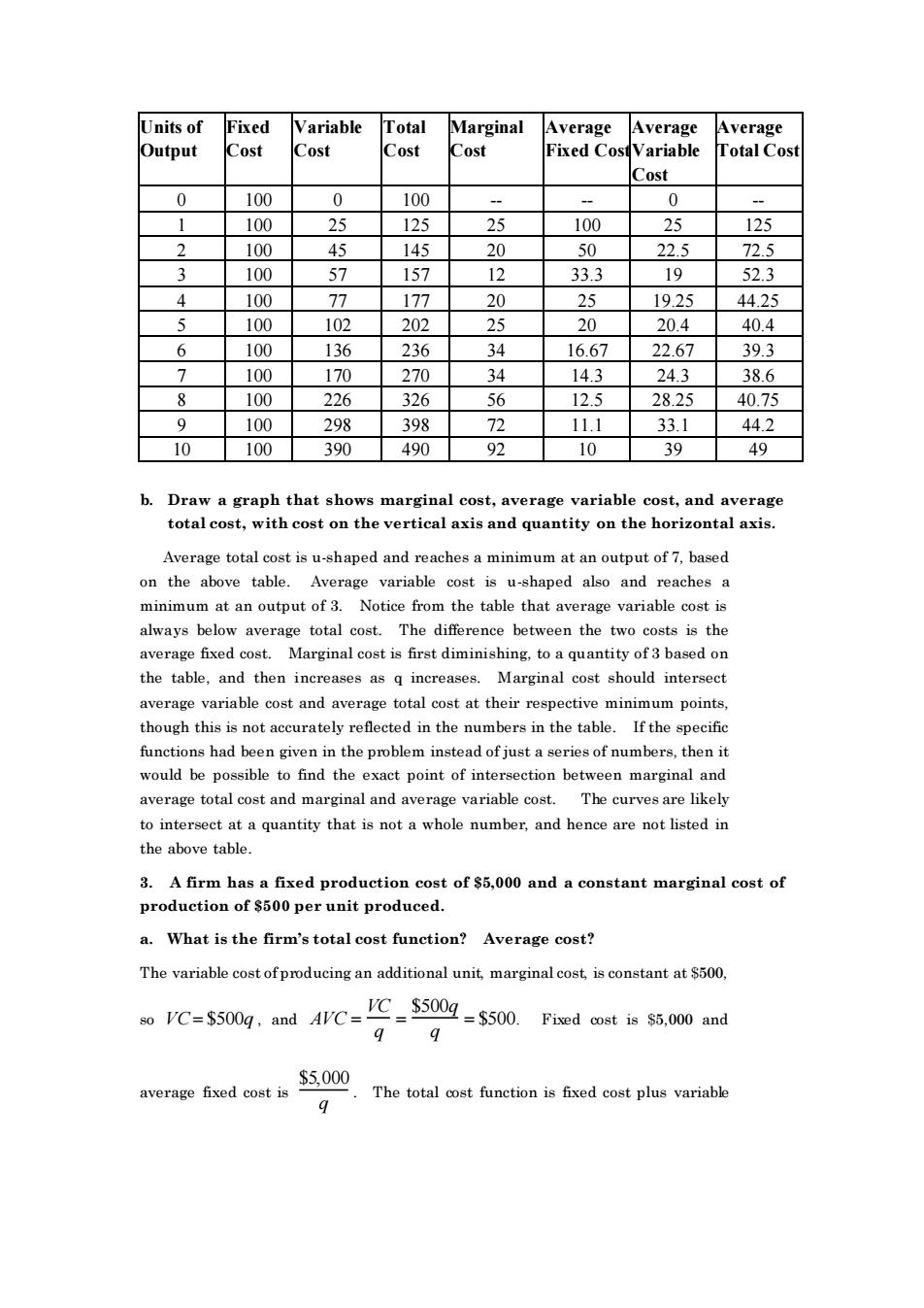
Units of Fixed Variable Total Marginal Average Outpu otal 05 100 0 100 0 100 )5 )5 100 125 100 1 1A5 75 100 5 15 33. 52.3 100 77 177 20 25 19.2544.25 100 107 20 20 20.4 404 100 136 236 16.67 67 39.3 100 170 270 34 14. 24.3 38.6 100 226 326 56 12.5 282540.75 0 100 20R 398 7 111 331 442 10 100 390 490 92 10 39 b.Draw a graph that shows marginal cost,average variable cost,and average total cost,with cost on the vertical axis and quantity on the horizontal axis. Average total cost is u-shaped and reaches a minimum at an output of 7.based on the above table. Average variable cost is u-shaped also and reaches a minimum at an output of. Notice from the table that aver variable cost always below average total cost. The difference between the two costs is the average fixed cost.Marginal cost is first diminishing,to a quantity of 3 based on the table.and then increases as g increases.Marginal cost should intersect average variable cost and average total cost at their respective minimum points though this is not curately in the table.If the functions had been given in the probem instead of just a seriesof numbers then i would be possible to find the exact point of intersection between marginal and average total cost and marginal and average variable cost,The curves are likely to intersect at a quantity that is not a whole number.and hence are not listed in the above table. 3.A firm has a fixed production cost of 5,000 and a constant marginal cost of production of $500 per unit produced. a.What is the firm's total cost function?Average cost? The variable cost of producing an additional unit marginal cost is constant at$500. VC=550g.and C=C==5500.s.00 ad 55,000 average fixed cost is The total ost function is fixed cost plus variable
Units of Output Fixed Cost Variable Cost Total Cost Marginal Cost Average Fixed Cost Average Variable Cost Average Total Cost 0 100 0 100 - - 0 - 1 100 25 125 25 100 25 125 2 100 45 145 20 50 22.5 72.5 3 100 57 157 12 33.3 19 52.3 4 100 77 177 20 25 19.25 44.25 5 100 102 202 25 20 20.4 40.4 6 100 136 236 34 16.67 22.67 39.3 7 100 170 270 34 14.3 24.3 38.6 8 100 226 326 56 12.5 28.25 40.75 9 100 298 398 72 11.1 33.1 44.2 10 100 390 490 92 10 39 49 b. Draw a graph that shows marginal cost, average variable cost, and average total cost, with cost on the vertical axis and quantity on the horizontal axis. Average total cost is u-shaped and reaches a minimum at an output of 7, based on the above table. Average variable cost is u-shaped also and reaches a minimum at an output of 3. Notice from the table that average variable cost is always below average total cost. The difference between the two costs is the average fixed cost. Marginal cost is first diminishing, to a quantity of 3 based on the table, and then increases as q increases. Marginal cost should intersect average variable cost and average total cost at their respective minimum points, though this is not accurately reflected in the numbers in the table. If the specific functions had been given in the problem instead of just a series of numbers, then it would be possible to find the exact point of intersection between marginal and average total cost and marginal and average variable cost. The curves are likely to intersect at a quantity that is not a whole number, and hence are not listed in the above table. 3. A firm has a fixed production cost of $5,000 and a constant marginal cost of production of $500 per unit produced. a. What is the firm’s total cost function? Average cost? The variable cost of producing an additional unit, marginal cost, is constant at $500, so VC= $500q , and AVC = VC q = $500q q = $500. Fixed cost is $5,000 and average fixed cost is $5,000 q . The total cost function is fixed cost plus variable
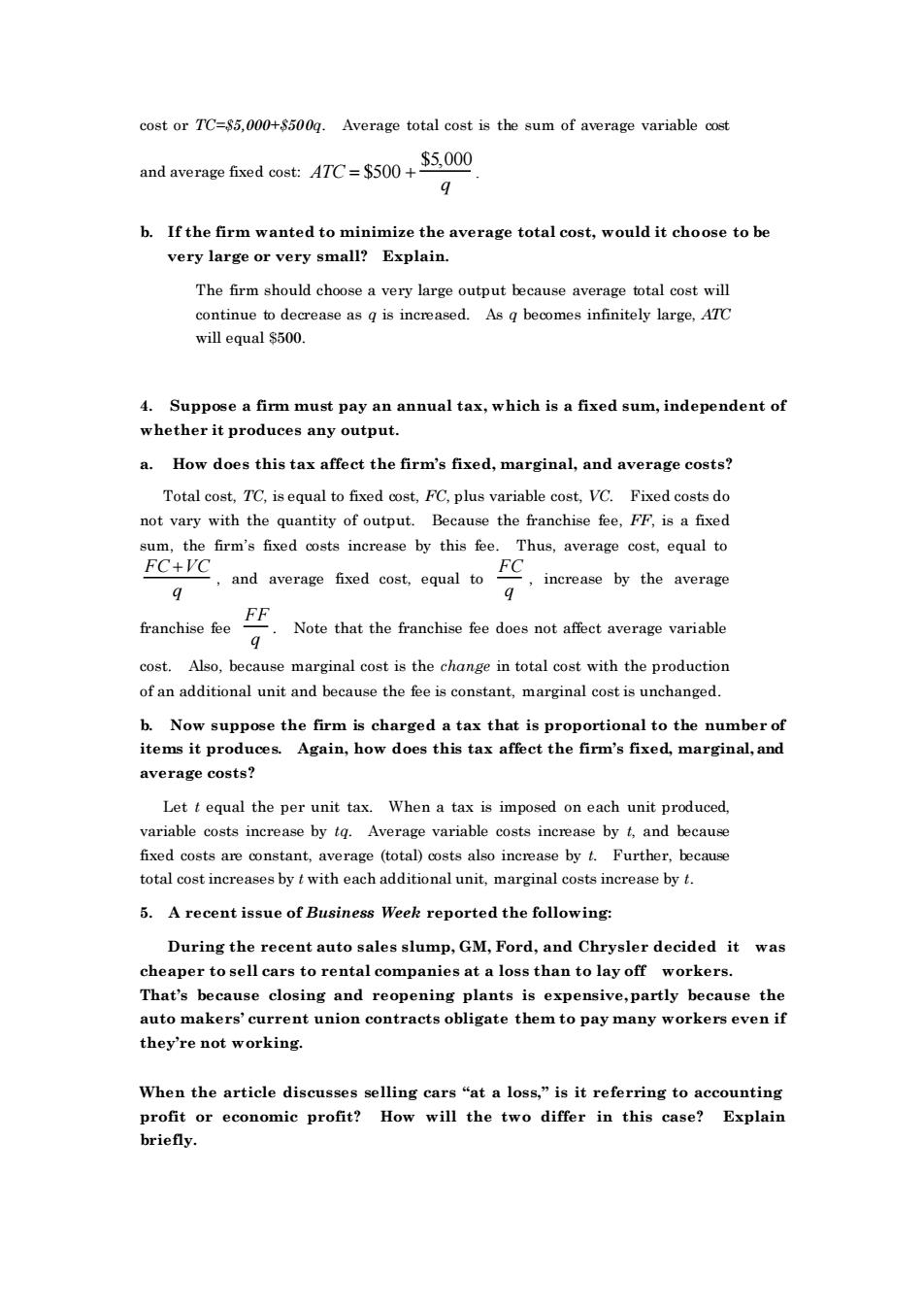
cost or TC=$5,000+8500g.Average total cost is the sum of average variable cost 9 b.If the firm wanted to minimize the average total cost,would it choose to be very large or very small?Explain. The firm should choose a very large output because average total cost will ne s i inced beomee infinitel arge,A 4.Suppose a firm must pay an annual tax,which is a fixed sum,independent of whether it produces any output. a.How does this tax affect the firm's fixed,marginal,and average costs? Total cost TC,is equal to fixed ost FC.plus variable cost,VC.Fixed costs do not vary with the quantity of output.Because the franchise fee,FF,is a fixed sum,the firm's fixed costs increase by this fee.Thus,average cost,equal to FC+VC .and average fixed oqutF increase by the average Note that the franchise fee does not affect average variable cost.Also,because marginal cost is the change in total cost with the production of an additional unit and because the fee is constant,marginal cost is unchanged. b.Now su rtional to the number of Again,how does this tax affect firm's fixe marginal,and average costs? Let t equal the per unit tax.When a tax is imposed on each unit produced, variable costs increase by lq.Average variable costs increase by /and because fixed costs are constant,average (total)costs also increase by.Further.because total cost increases by t with each additional unit,marginal costs increase by t. 5.A recent issue of Business Week reported the following: During the recent auto salesslump,GM,Ford,and Chrysler decided it was r tosell cars to rental companies at a loss than to lay off workers. closing and reopening pats is expesive.parcset auto makers'current union contracts obligate them to pay many workers even if they're not working When the article discusses selling cars"at a loss,"is it referring to ac counting How will the two differ in this case?Explain
cost or TC=$5,000+$500q. Average total cost is the sum of average variable cost and average fixed cost: ATC = $500 + $5,000 q . b. If the firm wanted to minimize the average total cost, would it choose to be very large or very small? Explain. The firm should choose a very large output because average total cost will continue to decrease as q is increased. As q becomes infinitely large, ATC will equal $500. 4. Suppose a firm must pay an annual tax, which is a fixed sum, independent of whether it produces any output. a. How does this tax affect the firm’s fixed, marginal, and average costs? Total cost, TC, is equal to fixed cost, FC, plus variable cost, VC. Fixed costs do not vary with the quantity of output. Because the franchise fee, FF, is a fixed sum, the firm’s fixed costs increase by this fee. Thus, average cost, equal to FC +VC q , and average fixed cost, equal to FC q , increase by the average franchise fee FF q . Note that the franchise fee does not affect average variable cost. Also, because marginal cost is the change in total cost with the production of an additional unit and because the fee is constant, marginal cost is unchanged. b. Now suppose the firm is charged a tax that is proportional to the number of items it produces. Again, how does this tax affect the firm’s fixed, marginal, and average costs? Let t equal the per unit tax. When a tax is imposed on each unit produced, variable costs increase by tq. Average variable costs increase by t, and because fixed costs are constant, average (total) costs also increase by t. Further, because total cost increases by t with each additional unit, marginal costs increase by t. 5. A recent issue of Business Week reported the following: During the recent auto sales slump, GM, Ford, and Chrysler decided it was cheaper to sell cars to rental companies at a loss than to lay off workers. That’s because closing and reopening plants is expensive,partly because the auto makers’ current union contracts obligate them to pay many workers even if they’re not working. When the article discusses selling cars “at a loss,” is it referring to accounting profit or economic profit? How will the two differ in this case? Explain briefly
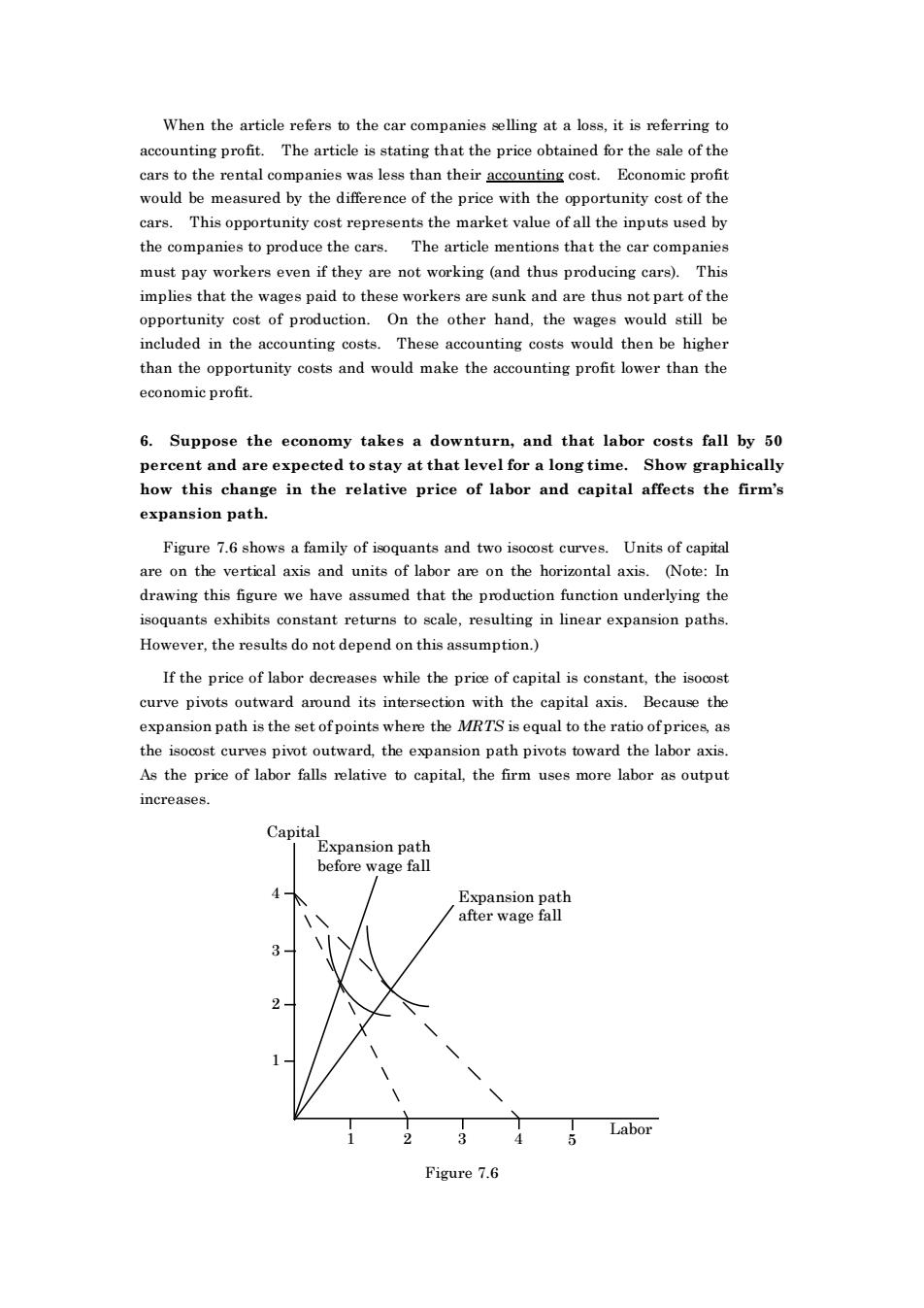
When the article refers to the car companies selling at a loss,it is referring to accounting profit.The article is stating that the price obtained for the sale of the cars to the rental companies was less than theirac inting cost. Economie prof would be measured by the difference of the price with the opportunity cost of th cars.This opportunity cost represents the market value of all the inputs used by the companies to produce the cars.The article mentions that the car companies must pay workers even if they are not working(and thus producing cars). This implies that the to these workerre dare thus notpart opportnitotO the atherd.the included in the accounting costs.These accounting costs would then be higher than the opportunity costs and would make the accounting profit lower than the economic profit. 6.Suppose the economy takes a downturn,and that labor costs fall by 50 percent and are expected to stay at that level for a long time.Show graphically how this change in the relative price of labor and capital affects the firm's expansion path. Figure 7.6 shows a family of isoquants and two isocost curves.Units of capital function underlying th isoquants exhibits constant returns to scale,resulting in linear expansion paths However.the results do not depend on this assumption.) If the price of labor decreases while the price of capital is constant.the isocost curve pivots outward around its intersection with the capital axis.Because the expansion path is the set of points where the ratio of pricesas es pivo outward,the expanion path pivots toward the labor axis As the price of labor falls relative to capital,the firm uses more labor as output increases. Capital Expansion path before wage fall Labo Figure 7.6
When the article refers to the car companies selling at a loss, it is referring to accounting profit. The article is stating that the price obtained for the sale of the cars to the rental companies was less than their accounting cost. Economic profit would be measured by the difference of the price with the opportunity cost of the cars. This opportunity cost represents the market value of all the inputs used by the companies to produce the cars. The article mentions that the car companies must pay workers even if they are not working (and thus producing cars). This implies that the wages paid to these workers are sunk and are thus not part of the opportunity cost of production. On the other hand, the wages would still be included in the accounting costs. These accounting costs would then be higher than the opportunity costs and would make the accounting profit lower than the economic profit. 6. Suppose the economy takes a downturn, and that labor costs fall by 50 percent and are expected to stay at that level for a long time. Show graphically how this change in the relative price of labor and capital affects the firm’s expansion path. Figure 7.6 shows a family of isoquants and two isocost curves. Units of capital are on the vertical axis and units of labor are on the horizontal axis. (Note: In drawing this figure we have assumed that the production function underlying the isoquants exhibits constant returns to scale, resulting in linear expansion paths. However, the results do not depend on this assumption.) If the price of labor decreases while the price of capital is constant, the isocost curve pivots outward around its intersection with the capital axis. Because the expansion path is the set of points where the MRTS is equal to the ratio of prices, as the isocost curves pivot outward, the expansion path pivots toward the labor axis. As the price of labor falls relative to capital, the firm uses more labor as output increases. Capital Labor 2 1 3 4 1 2 3 4 5 Expansion path before wage fall Expansion path after wage fall Figure 7.6
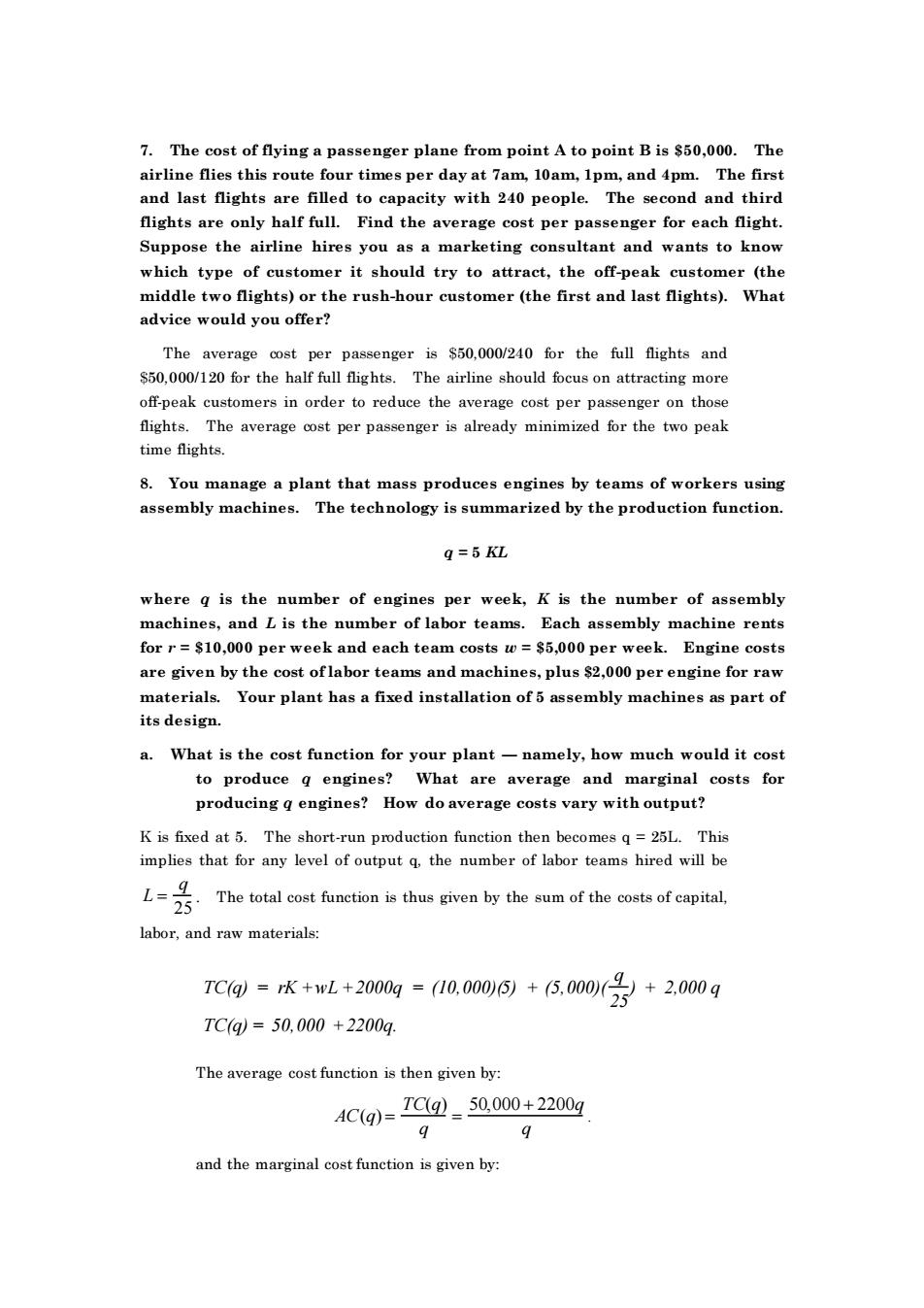
7.The cost of flying a passenger plane from point A to point Bis$50,000.Th airline flies this route four times per day at 7am,10am,Ipm,and 4pm The first and last flights are filled to capacity with 240 people.The second and third flights are only half full.Find the average cost per passenger for each flight. Suppose the airline hires you as a marketing consultant and wants to know which type of customer it should try to attract,the off-peak ustomer (the middle two flights)or the rush-hour customer(the first and last flights).What advice would you offer? The average cost per passenger is $50.000/240 for the full flights and $50,000/120 for the half full flights.The airline should focus on attracting more off-peak customers in order to reduce the average cost per passenger on those cost per pass enger is already minimized for the two peak 8.You manage a plant that mass produces engines by teams of workers using assembly machines.The technology is summarized by the production function. q=5 KL where g is the number of engines per week,K is the number of assembly machines,and L is the number of labor teams.Each assembly machine rents forr$10.000 per week and each team costsw$5.000 per week.Engine costs are given by the cost oflabor teams and machines,plus $2,000 per engine for raw materials.Your plant has a fixed installation of 5 assembly machines as part of its design. a.What is the cost function for your plant-namely,how much would it cost to produce g engines?What are average and marginal costs for producing g engines?How do average costs vary with output? implies that for any level of output the number of labor teams hired will be The total cost function tuiven by the sm of the oof apita labor,and raw materials: Tcg=k+wL+200g=(10.0006+5.00r号+2.000g TCg)=50,000+2200g The average cost function is then given by: AC(q)=TC4_50.00+200g 9 and the marginal cost function is given by:
7. The cost of flying a passenger plane from point A to point B is $50,000. The airline flies this route four times per day at 7am, 10am, 1pm, and 4pm. The first and last flights are filled to capacity with 240 people. The second and third flights are only half full. Find the average cost per passenger for each flight. Suppose the airline hires you as a marketing consultant and wants to know which type of customer it should try to attract, the off-peak customer (the middle two flights) or the rush-hour customer (the first and last flights). What advice would you offer? The average cost per passenger is $50,000/240 for the full flights and $50,000/120 for the half full flights. The airline should focus on attracting more off-peak customers in order to reduce the average cost per passenger on those flights. The average cost per passenger is already minimized for the two peak time flights. 8. You manage a plant that mass produces engines by teams of workers using assembly machines. The technology is summarized by the production function. q = 5 KL where q is the number of engines per week, K is the number of assembly machines, and L is the number of labor teams. Each assembly machine rents for r = $10,000 per week and each team costs w = $5,000 per week. Engine costs are given by the cost of labor teams and machines, plus $2,000 per engine for raw materials. Your plant has a fixed installation of 5 assembly machines as part of its design. a. What is the cost function for your plant — namely, how much would it cost to produce q engines? What are average and marginal costs for producing q engines? How do average costs vary with output? K is fixed at 5. The short-run production function then becomes q = 25L. This implies that for any level of output q, the number of labor teams hired will be L = q 25 . The total cost function is thus given by the sum of the costs of capital, labor, and raw materials: TC(q) = rK +wL +2000q = (10,000)(5) + (5,000)( q 25 ) + 2,000 q TC(q)= 50,000 +2200q. The average cost function is then given by: AC(q) = TC(q) q = 50,000 + 2200q q . and the marginal cost function is given by:
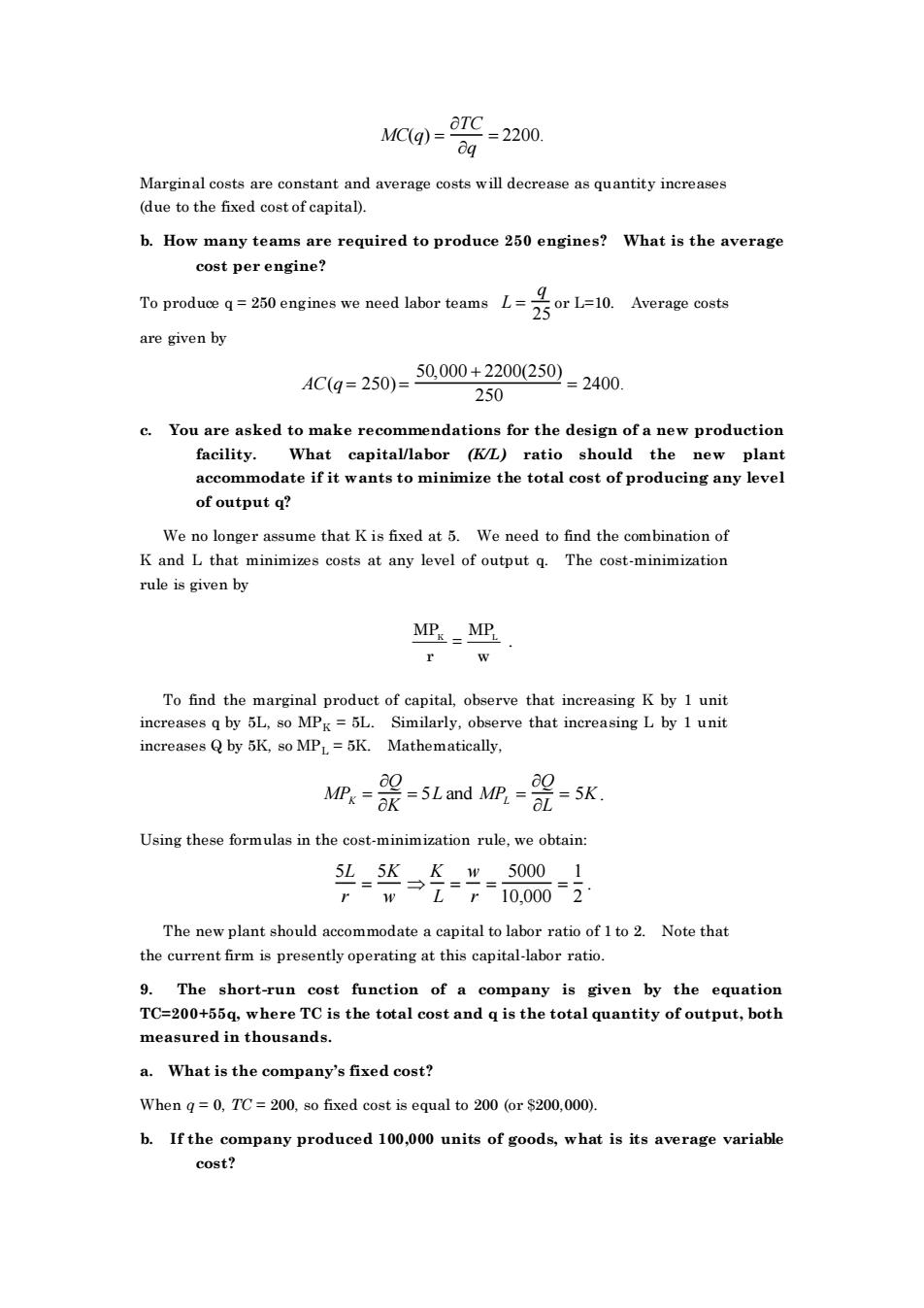
aTc MC(q)=aq =2200. b.How many teams are required to produce 250 engines?What is the average cost per engine? Toprodu2 ngne we need labor teams10.Average cost are given by 4Cg=250)=5000+20250-240 250 c.You are asked to make recommendations for the design of a new production facility. What capital/labor (KL)ratio should the new plant accommodate if it wants to minimize the total cost of producing any level of output g? We no longer assume that Kis fixed at 5.We need to find the combination of K and L that minimizes costs at any level of outputq.The cost-minimization rule is given by MPMP w To find the marginal product of capital,observe that increasing K by 1 unit increases q by 5L,so MPK=5L.Similarly,observe that increasing L by 1 unit increases Q by 5K,so MPL=5K.Mathematically, Using these formulas in the cost-minimization rule.we obtain 5000 r The new plant should accommodate a capital to labor ratio of I to 2.Note that the current firm is presently operating at this capital-labor ratio. 9.The short-run cost function of a company is given by the equation TC=200+55q,where TC is the total cost and q is the total quantity of output,both measured in thousands a.What is the company's fixed cost? When=0.TC=200.so fixed cost is equal to 200.000) b.If the company produced 100,000 units of goods,what is its average variable cost?
MC(q) = TC q = 2200. Marginal costs are constant and average costs will decrease as quantity increases (due to the fixed cost of capital). b. How many teams are required to produce 250 engines? What is the average cost per engine? To produce q = 250 engines we need labor teams L = q 25 or L=10. Average costs are given by AC(q = 250) = 50,000 + 2200(250) 250 = 2400. c. You are asked to make recommendations for the design of a new production facility. What capital/labor (K/L) ratio should the new plant accommodate if it wants to minimize the total cost of producing any level of output q? We no longer assume that K is fixed at 5. We need to find the combination of K and L that minimizes costs at any level of output q. The cost-minimization rule is given by MP r = MP w . K L To find the marginal product of capital, observe that increasing K by 1 unit increases q by 5L, so MPK = 5L. Similarly, observe that increasing L by 1 unit increases Q by 5K, so MPL = 5K. Mathematically, MPK = Q K = 5L and MPL = Q L = 5K . Using these formulas in the cost-minimization rule, we obtain: 5L r = 5K w K L = w r = 5000 10,000 = 1 2 . The new plant should accommodate a capital to labor ratio of 1 to 2. Note that the current firm is presently operating at this capital-labor ratio. 9. The short-run cost function of a company is given by the equation TC=200+55q, where TC is the total cost and q is the total quantity of output, both measured in thousands. a. What is the company’s fixed cost? When q = 0, TC = 200, so fixed cost is equal to 200 (or $200,000). b. If the company produced 100,000 units of goods, what is its average variable cost?

With 100.000 units,=100.Variable cost is 55g=(55)(100)=5500 (or $5,500.000). q 100 e.What is its marginal cost per unit produced? With constant average variable cost,marginal cost is equal to average variable cost,$55(or $55.000). d.What is its average fixed cost? At q=100,average fixed cost is TFC_$200 =$20rS2.000) 100 e.Suppose the company borrows money and expands its factory.Its fixed cost rises by $50,000,but its variable cost falls to $45,000 per 1,000 units.The cost of interest(i)also enters into the equation.Each one-point increase in the interest rate raises costs by S3.000.Write the new cost equation. Fixed cost changes from 200 to 250.measured in thousands.Variable cost decrases from 55 to5.also measured in thousands. Fixed cost also includes interest charges:3i.The costequation is C=250+45g+3 10.A chair manufacturer hires its assembly-line labor for $30 an hour and calculates that the rental cost of its machinery is $15 per hour.Suppose that a chair can be produced using 4 hours of labor or machinery in any combination. If the firm is c urrently using3 hours of labor for each hour of machine time,is it imizing its of prod an? Ifso,why?If not,ho can it in mprove the situation?Graphically illustrate the isoquant and the two isocost lines,for the current combination of labor and capital and the optimal combination of labor and capital. If the firm can produce one chair with either four hours of labor or four hours of capital.machinery.or any combination.then the isoquant is a straight line with a slope of-1 and intercept atK=4andL=4.as depicted in figure 7.10. 20 The isocost line,TC=30L+15K has a slope of- 15-when plotted with capital on the vertical axis and has intercepts at =I and The oost minimizing point is a corner solution.where L=0 and K=4.At that point.total cost is $60. ilustrated on the graph The first from the origin and represents the higher cos($105)ofus ing3 labor and 1 capita The firm will find it optimal to move to the second isocost line which is closer to the origin,and which represents a lower cost($60).In general,the firm wants to be on the lowest isocost line possible,which is the lowest isocost line that still intersects the given isoquant
With 100,000 units, q = 100. Variable cost is 55q = (55)(100) = 5500 (or $5,500,000). Average variable cost is TVC q = $5500 100 = $55, or $55,000. c. What is its marginal cost per unit produced? With constant average variable cost, marginal cost is equal to average variable cost, $55 (or $55,000). d. What is its average fixed cost? At q = 100, average fixed cost is TFC q = $200 100 = $2 or ($2,000). e. Suppose the company borrows money and expands its factory. Its fixed cost rises by $50,000, but its variable cost falls to $45,000 per 1,000 units. The cost of interest (i) also enters into the equation. Each one-point increase in the interest rate raises costs by $3,000. Write the new cost equation. Fixed cost changes from 200 to 250, measured in thousands. Variable cost decreases from 55 to 45, also measured in thousands. Fixed cost also includes interest charges: 3i. The cost equation is C = 250 + 45q + 3i. 10. A chair manufacturer hires its assembly-line labor for $30 an hour and calculates that the rental cost of its machinery is $15 per hour. Suppose that a chair can be produced using 4 hours of labor or machinery in any combination. If the firm is currently using 3 hours of labor for each hour of machine time, is it minimizing its costs of production? If so, why? If not, how can it improve the situation? Graphically illustrate the isoquant and the two isocost lines, for the current combination of labor and capital and the optimal combination of labor and capital. If the firm can produce one chair with either four hours of labor or four hours of capital, machinery, or any combination, then the isoquant is a straight line with a slope of -1 and intercept at K = 4 and L = 4, as depicted in figure 7.10. The isocost line, TC = 30L + 15K has a slope of − 30 15 = −2 when plotted with capital on the vertical axis and has intercepts at K = TC 15 and L = TC 30 . The cost minimizing point is a corner solution, where L = 0 and K = 4. At that point, total cost is $60. Two isocost lines are illustrated on the graph. The first one is further from the origin and represents the higher cost ($105) of using 3 labor and 1 capital. The firm will find it optimal to move to the second isocost line which is closer to the origin, and which represents a lower cost ($60). In general, the firm wants to be on the lowest isocost line possible, which is the lowest isocost line that still intersects the given isoquant